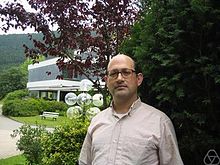This biography of a living person needs additional citations for verification. Please help by adding reliable sources. Contentious material about living persons that is unsourced or poorly sourced must be removed immediately from the article and its talk page, especially if potentially libelous.Find sources: "Ofer Gabber" – news · newspapers · books · scholar · JSTOR (January 2017) (Learn how and when to remove this message)
This article includes a list of references, related reading, or external links, but its sources remain unclear because it lacks inline citations. Please help improve this article by introducing more precise citations. (September 2018) (Learn how and when to remove this message)
Ofer Gabber | |
|---|---|
עופר גאבר | |
 | |
| Born | May 16, 1958 |
| Alma mater | Harvard University |
| Known for | Algebraic geometry |
| Awards | Erdős Prize (1981), Prix Thérèse Gautier (2011) |
| Scientific career | |
| Fields | Mathematics |
| Institutions | Institut des Hautes Études Scientifiques |
| Doctoral advisor | Barry Mazur |
Ofer Gabber (עופר גאבר; born May 16, 1958) is a mathematician working in algebraic geometry.
Life
[edit]In 1978 Gabber received a Ph.D. from Harvard University for the thesis Some theorems on Azumaya algebras, written under the supervision of Barry Mazur.[1] Gabber has been at the Institut des Hautes Études Scientifiques in Bures-sur-Yvette in Paris since 1984 as a CNRS senior researcher. He won the Erdős Prize in 1981 and the Prix Thérèse Gautier from the French Academy of Sciences in 2011. In 1981 Gabber with Victor Kac published a proof of a conjecture stated by Kac in 1968.[2]
Books
[edit]- With Lorenzo Ramero: Almost Ring Theory, Springer, Lecture Notes in Computer Science, vol 1800, 2003.
- With Brian Conrad, Gopal Prasad: Pseudo-reductive Groups, Cambridge University Press, 2010; 2015, 2nd edition[3]
See also
[edit]References
[edit]- ^ Ofer Gabber at the Mathematics Genealogy Project
- ^ Gabber, Ofer; Kac, Victor G. (1981). "On defining relations of certain infinite-dimensional Lie algebras". Bulletin of the American Mathematical Society. 5 (2): 185–190. doi:10.1090/S0273-0979-1981-14940-5. ISSN 0273-0979.
- ^ Zaldivar, Felipe (October 6, 2015). "Review of Pseudo-reductive Groups, 2nd edition, by Brian Conrad, Ofer Gabber, and Gopal Prasad". MAA Reviews, Mathematical Association of America.
| International | |
|---|---|
| National | |
| Academics | |
| Other | |